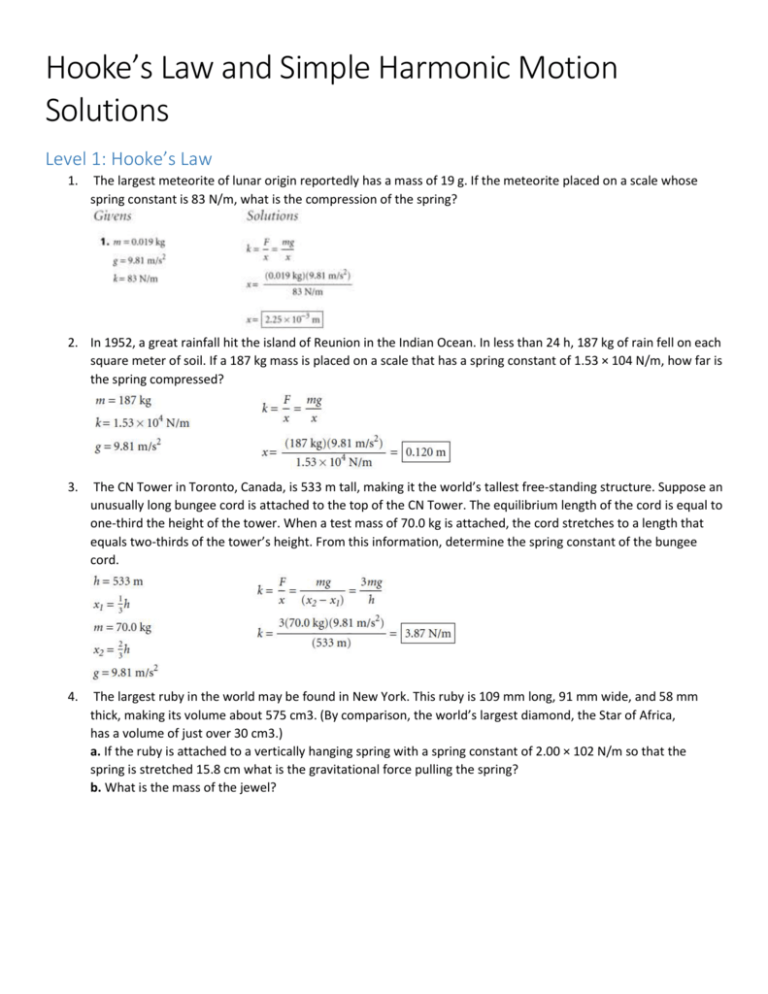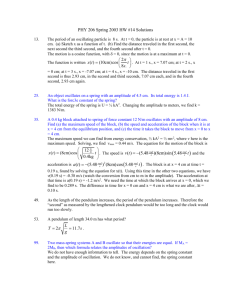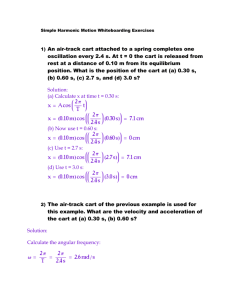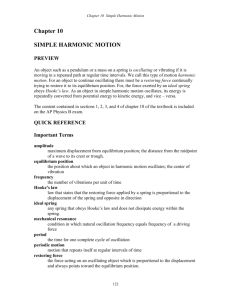Practice Simple Harmonic Motion Solutions
advertisement

Hooke’s Law and Simple Harmonic Motion Solutions Level 1: Hooke’s Law 1. The largest meteorite of lunar origin reportedly has a mass of 19 g. If the meteorite placed on a scale whose spring constant is 83 N/m, what is the compression of the spring? 2. In 1952, a great rainfall hit the island of Reunion in the Indian Ocean. In less than 24 h, 187 kg of rain fell on each square meter of soil. If a 187 kg mass is placed on a scale that has a spring constant of 1.53 × 104 N/m, how far is the spring compressed? 3. The CN Tower in Toronto, Canada, is 533 m tall, making it the world’s tallest free-standing structure. Suppose an unusually long bungee cord is attached to the top of the CN Tower. The equilibrium length of the cord is equal to one-third the height of the tower. When a test mass of 70.0 kg is attached, the cord stretches to a length that equals two-thirds of the tower’s height. From this information, determine the spring constant of the bungee cord. 4. The largest ruby in the world may be found in New York. This ruby is 109 mm long, 91 mm wide, and 58 mm thick, making its volume about 575 cm3. (By comparison, the world’s largest diamond, the Star of Africa, has a volume of just over 30 cm3.) a. If the ruby is attached to a vertically hanging spring with a spring constant of 2.00 × 102 N/m so that the spring is stretched 15.8 cm what is the gravitational force pulling the spring? b. What is the mass of the jewel? 5. A force of 10 N stretches a spring that has a spring constant of 20 N/m. The potential energy stored in the spring is: (A) 2.5 J (B) 5.0 J (C) 10 J (D) 40 J (E) 200 J Two step problem. Do F = kΔx, solve for Δx then sub in the Usp = ½ kΔx2 6. A compressed spring has 16 J of potential energy. What is the maximum speed it can impart to a 2 kg object? (A) 2.8 m/s (B) 4.0 m/s (C) 5.6 m/s (D) 8.0 m/s (E) 16 m/s 7. A mass, M, is at rest on a frictionless surface, connected to an ideal horizontal spring that is unstretched. A person extends the spring 30 cm from equilibrium and holds it by applying a 10 N force. The spring is brought back to equilibrium and the mass connected to it is now doubled to 2M. If the spring is extended back 30 cm from equilibrium, what is the necessary force applied by the person to hold the mass stationary there? (A) 20 N (B) 14.1 N (C) 10 N (D) 7.07 N (E) 5 N Based on F = k Δx. The mass attached to the spring does not change the spring constant so the same resistive spring force will exist, so the same stretching force would be required 8. A block of mass 3.0 kg is hung from a spring, causing it to stretch 12 cm at equilibrium, as shown. The 3.0 kg block is then replaced by a 4.0 kg block, and the new block is released from the position shown, at which the spring is unstretched. How far will the 4.0 kg block fall before its direction is reversed? (A) 9 cm (B) 18 cm (C) 24 cm (D) 32 cm (E) 48 cm Level 3: Oscillations The next couple questions relate to this picture. 9. A block oscillates without friction on the end of a spring as shown above. The minimum and maximum lengths of the spring as it oscillates are, respectively, xmin and xmax. The graphs below can represent quantities associated with the oscillation as functions of the length x of the spring. Which graph can represent the total mechanical energy of the block-spring system as a function of x ? (A) A (B) B (C) C (D) D (E) E Answer: E Only conservative forces are acting which means mechanical energy must be conserved so it stays constant as the mass oscillates 10. Which graph can represent the kinetic energy of the block as a function of x ? (A) A (B) B (C) C (D) D (E) E Answer: D The box momentarily stops at x(min) and x(max) so must have zero K at these points. The box accelerates the most at the ends of the oscillation since the force is the greatest there. This changing acceleration means that the box gains speed quickly at first but not as quickly as it approaches equilibrium. This means that the KE gain starts of rapidly from the endpoints and gets less rapid as you approach equilibrium where there would be a maximum speed and maximum K, but zero force so less gain in speed. This results in the curved graph. 11. An object is attached to a spring and oscillates with amplitude A and period T, as represented on the graph. The nature of the velocity v and acceleration a of the object at time T/4 is best represented by which of the following? (A) v > 0, a > 0 (B) v > 0, a < 0 (C) v > 0, a = 0 (D) v = 0, a < 0 (E) v = 0, a = 0 Answer: D At T/4 the mass reaches maximum + displacement where the restoring force is at a maximum and pulling in the opposite direction and hence creating a negative acceleration. At maximum displacement the mass stops momentarily and has zero velocity 12. A mass on the end of a spring oscillates with the displacement vs. time graph shown. Which of the following statements about its motion is INCORRECT? (A) The amplitude of the oscillation is 0.08 m. (B) The frequency of oscillation is 0.5 Hz. (C) The mass achieves a maximum in speed at 1 sec. (D) The period of oscillation is 2 sec. (E) The mass experiences a maximum in the size of the acceleration at t=1.5 sec Answer: A The amplitude from the graph is 0.04 not 0.08, the rest are true The next couple questions refer to this picture 13. Which of the following graphs shows the kinetic energy K of the particle as a function of time t for one cycle of motion? Answer: B 14. Which of the following graphs shows the kinetic energy K of the particle as a function of its displacement x ? Answer: C 15. Which of the following is true for a system consisting of a mass oscillating on the end of an ideal spring? (A) The kinetic and potential energies are equal to each other at all times. (B) The kinetic and potential energies are both constant. (C) The maximum potential energy is achieved when the mass passes through its equilibrium position. (D) The maximum kinetic energy and maximum potential energy are equal, but occur at different times. (E) The maximum kinetic energy occurs at maximum displacement of the mass from its equilibrium position Answer: D Energy is conserved here and switches between kinetic and potential which have maximums at different locations Level 4: Equations 16. A mass m is attached to a spring with a spring constant k. If the mass is set into simple harmonic motion by a displacement d from its equilibrium position, what would be the speed, v, of the mass when it returns to the equilibrium position? Answer: E Energy conservation. Usp = K ½ k d2 = ½ mv2 17. A 1.0 kg mass is attached to the end of a vertical ideal spring with a force constant of 400 N/m. The mass is set in simple harmonic motion with an amplitude of 10 cm. The speed of the 1.0 kg mass at the equilibrium position is (A) 2 m/s (B) 4 m/s (C) 20 m/s (D) 40 m/s (E) 200 m/s Answer: A Using energy conservation. Usp = K ½ k A2 = ½ mvm2 solve for v 18. A platform of mass 2 kg is supported by a spring of negligible mass as shown. The platform oscillates with a period of 3 s when the platform is pushed down and released. What must be the mass of a block that when placed on the platform doubles the period of oscillation to 6 s? (A) 1 kg (B) 2 kg (C) 4 kg (D) 6 kg (E) 8 kg Answer: D Based on T = 2π √(m/k), in order to double the period, the mass would have to be increased by 4x the original amount. Here is the tricky part …. you are to increase the mass to 4 x its original value by adding mass the to 2kg tray. So to make the total mass have a value of 8 kg, only 6 kg of extra mass would need to be added to the tray. 19. A mass M suspended by a spring with force constant k has a period T when set into oscillation on Earth. Its period on Mars, whose mass is about 1/9 and radius 1/2 that of Earth, is most nearly (A) T/3 (B) 2T/3 (C) T (D) 3T/2 (E) 3T Answer: C Spring Equations Free Response C1989M3. A 2-kilogram block is dropped from a height of 0.45 meter above an uncompressed spring, as shown above. The spring has an elastic constant of 200 newtons per meter and negligible mass. The block strikes the end of the spring and sticks to it. a. Determine the speed of the block at the instant it hits the end of the spring b. Determine the force in the spring when the block reaches the equilibrium position c. Determine the distance that the spring is compressed at the equilibrium position d. Determine the speed of the block at the equilibrium position e. Determine the resulting amplitude of the oscillation that ensues f. Is the speed of the block a maximum at the equilibrium position, explain. g. Determine the period of the simple harmonic motion that ensues Solution Free Response Practice 1983B2. A block of mass M is resting on a horizontal, frictionless table and is attached as shown above to a relaxed spring of spring constant k. A second block of mass 2M and initial speed v o collides with and sticks to the first block Develop expressions for the following quantities in terms of M, k, and v o a. v, the speed of the blocks immediately after impact b. x, the maximum distance the spring is compressed c. T, the period of the subsequent simple harmonic motion Solution Level 5: Pendulums 20. What is the period of a simple pendulum if the cord length is 67 cm and the pendulum bob has a mass of 2.4 kg. (A) 0.259 s (B) 1.63 s (C) 3.86 s (D) 16.3 s (E) 24.3 s Answer: B The mass is irrelevant, only the length matters. T is found with 2π √(L/g) 21. The length of a simple pendulum with a period on Earth of one second is most nearly (A) 0.12 m (B) 0.25 m (C) 0.50 m (D) 1.0 m (E) 10.0 m Answer: B Sub into T = 2π √(L/g) and solve for L 22. An object swings on the end of a cord as a simple pendulum with period T. Another object oscillates up and down on the end of a vertical spring also with period T. If the masses of both objects are doubled, what are the new values for the Periods? Answer: B Pendulum is unaffected by mass. Mass-spring system has mass causing the T to change proportional to √m so since the mass is doubled the period is changed by √2 23. A simple pendulum of length l, whose bob has mass m, oscillates with a period T. If the bob is replaced by one of mass 4m, the period of oscillation is Answer: C Mass does not affect the period of a pendulum Pendulum Free Response 1975B7. A pendulum consists of a small object of mass m fastened to the end of an inextensible cord of length L. Initially, the pendulum is drawn aside through an angle of 60° with the vertical and held by a horizontal string as shown in the diagram above. This string is burned so that the pendulum is released to swing to and fro. a. In the space below draw a force diagram identifying all of the forces acting on the object while it is held by the string b. Determine the tension in the cord before the string is burned. c. Show that the cord, strong enough to support the object before the string is burned, is also strong enough to support the object as it passes through the bottom of its swing. d. The motion of the pendulum after the string is burned is periodic. Is it also simple harmonic? Why, or why not? Solution











